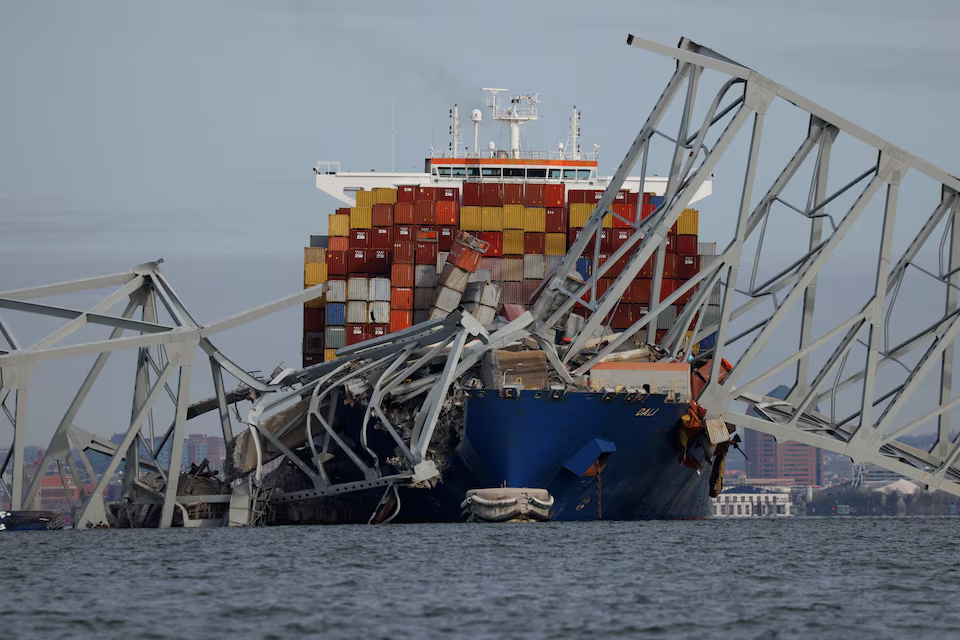
On March 26, the Singapore-flagged cargo vessel Dali crashed into the Francis Scott Key Bridge in the U.S. city of Baltimore, taking the lives of six bridge construction workers. Since then, the city-state has sent shipping regulators to the U.S. for an investigation that brings international maritime laws to the fore, as authorities determine liability and damages arising from the wreckage.
At around 12:40 a.m. local time, Dali commenced its journey from Baltimore bound for Colombo, Sri Lanka, with the ultimate destination of Yantian, China. Around 1:15 a.m., the vessel experienced a loss of power and propulsion before crashing into the Key Bridge around 1:28 a.m.
While investigations into the crash and liability arising from its aftermath will be led by U.S. regulators and port authorities, Singapore’s Maritime and Port Authority (MPA) has said is it also conducting an investigation to determine breach of Singapore law, as the vessel was sailing under a Singapore flag.
Any ship that is Singapore-flagged, i.e. registered under the Singapore Registry of Ships (SRS), will be bound by the laws of Singapore, explains Prakaash Silvam, partner at Singapore-based law firm Oon & Bazul.
Under international maritime law, the country where the ship is registered is called the flag state and it is open to the shipowner to register the ship in a country different from the one whose citizenship he or she holds.
Silvam explains that any ship registered under the Singapore flag will have the advantage of the tax exemptions and various incentive schemes available in the country. Shipowners also benefit from the ease of incorporating a Singapore company as only Singapore citizens, permanent residents or companies incorporated in Singapore may be registered as owners of Singapore-flagged ships, although these companies can be locally or foreign-owned.
As of January 2024, there were about 4,000 vessels being administered under the Singapore Registry of Ships, making it the fifth-largest ship registry in the world as per Lloyd’s List 2023
“The Singapore Registry of Ships is in charge of monitoring ships flying the Singapore flag and making sure the owners of these ships comply with national and international laws pertaining to issues like environmental preservation and crew safety. Once a ship adopts a flag, it becomes subject to the laws of that nation, and each nation is in charge of the ships that fly its flag,” says Silvam.
The MPA, which carries out investigations for the SRS, will investigate whether the ship complied with all statutory requirements under Singapore law. The Transport Safety Investigation Bureau (TSIB), a statutory board under Singapore’s Ministry of Transport, is being sent to Baltimore primarily for conducting an independent marine safety investigation under the International Maritime Organisation’s Casualty Investigation Code to identify lessons that will help prevent future marine casualties.
However, as the MPA has already clarified, TSIB’s scope of work in Baltimore will not include assigning blame or establishing liability for the incident, adds Silvam.
THE QUESTION OF LIABILITY
The different stakeholders in this incident on whom the liability can potentially fall are the shipowners, managers, charterers, insurers, reinsurers, the master of the vessel. There are also the two pilots who had taken over from the ship’s captain for the specific purpose of navigating the vessel in Baltimore waters who may come into the picture.
Silvam explains that the most important stakeholders will be the insurers, the Britannia Protection and Indemnity Club, which could be hit with claims worth several millions of dollars. “This accident is likely to be a record loss for shipping insurance,” he says.
“It all depends on how the parties involved allocated risk, but more often than not, it will be the insurers (and their reinsurers) who will bear the responsibility for civil liability in the form of financial penalties and compensations,” Silvam adds.
The owner of the ship, Grace Ocean, is a Singapore-registered company that is a subsidiary of a Hong Kong group. The vessel’s manager, Synergy Marine Group, is also incorporated in Singapore. The owner and manager have filed a petition in Maryland, U.S., for exoneration from liability, or at most limitation of liability to $43 million under a U.S. maritime law that could curtail their vulnerability to the value of the vessel plus its “pending freight.”
“Interestingly, this act was invoked in 1912 as well when the Titanic sank after hitting an iceberg,” says Silvam.
Liability may also fall on the ship’s charterer, Maersk, as well as its classification society ClassNK, who will be involved in preparing technical assessment and stability calculations that will help the U.S. Coast Guard to plan and execute vessel salvage operations.
“While classification societies usually tend to exclude their liability in the contract itself, it cannot be ruled out that the plaintiffs will have the option to sue ClassNK on the basis of a tort of negligent misrepresentation. However, U.S. courts have in the past interpreted such claims in the favour of classification societies holding that they don’t guarantee seaworthiness and are only performing their duty of inspecting the vessel and ensuring compliance with relevant standards. This is done to reemphasize shipowners' non-delegable duty to maintain a seaworthy vessel,” Silvam explains.
As the crash involved the tragic deaths of six construction workers on the bridge, the case could also see criminal liability meted out to the stakeholders.
“It is still premature to determine whether there is criminal liability at this juncture when the investigations are still ongoing. I expect that criminal charges may be brought if the investigations uncover grossly negligent behaviour by the parties involved, which resulted in the incident,” explains Silvam.
“As matters stand, if shipowners succeed in limiting their liability at $43 million, there will likely be enough money to cover the personal injury claims but not the property damage. Given so, I expect the stakeholders who have incurred property damage to actively challenge the shipowners’ right to limit their liability at $43 million,” he adds.


